Family Stories: The Union-Chipman Mill and the families who worked there…

Employees waiting for work shift
In searching for history on the Union-Chipman Mill in Union Point, I found a gold mine of info in a financial document…. treasures waiting for me to discover.

I might assume that when the Fair Labor Standards Act of 1938 went into place… many businesses were audited. The FLSA is a federal law which establishes minimum wages, overtime pay eligibility, record keeping, and child labor standards affecting both fulltime and part time workers in the private sector and in federal, state and local governments. President Franklin D. Roosevelt referred to it as the most important piece of “new deal” legislature since the Social Security Act of 1935.
Like many documents you click online… discovering that you really can’t download… or telling you access only at local library. Well as I never give up right away…. and that paid off for me as I noticed a link to actually download if you were affiliated with a college. Hmm… I scrolled down and located Yale as an affiliate, and bingo.. an hour later, with a friends help, it was in my drop box. I was so excited to finally have my hands on it!
Granddaddy Bryan received this coin when he retired from the mill. In possession of granddaughter Paulette.
Almost everyone in Union Point has worked, or had a family member who worked, in the mill… it pretty much supported the entire town until it’s final closing in 2001. My grandfather, Paul Bryan, worked there for 38 years. His brothers, Leon, Clyde, and Gordon, and even my grandmother, Evelyn Bryan, also worked there along with several cousins. My mother worked there after she married, but only for a few weeks… she hated it!

Map showing mill location and mill housing
This document on the Union Manufacturing Company was of a study done by the Research and Statistics Branch of the United States Department of Labor, Wage and Hour Division. It was written in 1941, from data studied between October of 1938 through March 1941 of their payroll deductions. I found this document at the University of Illinois library… and am still wondering how or why they came to have this document?
Samuel H. Sibley began bringing hosiery mill machinery from Athens, in 1890, to Union Point… he had an idea, and that was the beginning of the towns textile mill industry. Construction didn’t begin until 1897, and by 1898 the mill was incorporated as the Union Manufacturing Company. The first charter to begin the mill was signed by several local family names… Hart, Carlton, Newsome, Thornton, Fluker, Sibley and Bryan. The mill soon began producing cotton underwear… later changing to socks and yarns.
Making the socks!
All my father’s socks came from the mill… whenever we visited my grandparents, there was always a few boxes of socks waiting for him. I don’t remember if my socks came from there… actually I don’t even remember wearing socks as a kid… living in the south, it was often either barefoot or flip flops for me! I even remember granddaddy buying socks for my husband when I married in 1971. They initially produced the yarn used in knitting socks in the beginning, but later imported it when it became un-productive to produce. Granddaddy saved many of those cones the yarn was wrapped around for my mother once… she made a circular-type craft with a mirror in the center when we lived in Perry.
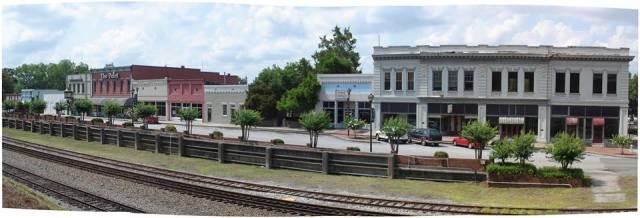
The “one-sided street” of Union Point, Georgia
The small one-street town of Union Point was growing… due to the railroad and the mill! It was the mill which supported the people… and which grew the town! The town soon needed more housing for the workers, so like many mills all over the country… they built housing. About 1900, a subsidiary of the Union Point Improvement Company was began by the Hart Family. Mill housing was built on surrounding mill property along Wooten Ave., off Lamb Avenue. Later additional housing was built north of the mill along the streets off Witcher, Newcome, Hilliard, Ray, Underwood, Hendry, Dennis, and also on Carlton and Hart Avenue.
Mill housing began to be rented out in the 1920’s and 30’s at the weekly rate of fifty-cents per room, per week; at that time there was no electricity or sewage services. Heat was supplied by coal… at a cost of $3 a ton to the mill. The U. M. Co. owned all the mill housing until selling it off in 1950-60 to the renters who continued to live there. Four-room houses sold for $1, 500 at that time. My cousins grandparents, Louella (Cheatham) and Jim Lewis, was one of the last renters of the millhousing and finally was allowed to purchase it for $2400… possibly in the late sixties. By the late seventies, the mill began buying back all their mill housing they had sold… all but the house of Louella and Jim Lewis. They were the last remaining mill house near the mill, at 303 Lamb Avenue, to never be sold back to Union-Chipman Manufacturing Co.

Louella and Jim Lewis’ mill home at 303 Lamb Avenue was actually a little square house, no hall… each room leading into another, with a tiny front porch where everyone enjoyed to sit. Today the mill has built up around this little house, with fencing surrounding it from the mill. This was the only house next to the mill that was never bought back. These type of mill houses were often referred to as “pyramid” housing… in reference to the shaping of the roof.
The Lewis home was very well-known on Lamb Street for the black mynah bird called “Joe” who often sat in his cage watching and talking to everyone who passed by on the sidewalk. When Joe mimicked the train whistle, you had to look twice to see if the train was really there. I can only imagine the workers walking by the Lewis home… looking over to see if Joe was out in his cage… and probably saying “Hi Joe.“
My cousin, Cindy (Bryan-Moore) remembers Joe always being at her grandparents home as long as she can remember. But one thing you didn’t do was try and pet Joe… he never came out of his cage and you never put your fingers inside if you didn’t want to feel the wrath of his beak! One of the most remembered sayings of Joe was “Awe, birds can’t talk” in Mr. Jim’s voice… all his words were only in his voice. If Joe distinguished a woman walking by, you can be assured he gave his best whistle (wolf whistle). There’s a story told that a disgruntled husband once knocked on Mr. Jim’s door to complain that he had whistled at his wife… hope that ended well! My mother often talked about “Joe’s” loud whistle he gave when hearing a woman’s voice!
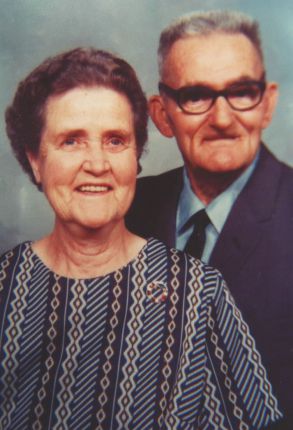
Evelyn (Little) & Paul P. Bryan… my paternal grandparents
My grandparents lived only a few houses down from “Joe”… as Mama remembers spending the night with her in-laws after she married; it must have been just before granddaddy finished building their house on Binns St. Even after moving just a short ways away, my grandmother still visited Louelle and I have a vague memory of going along with her and seeing Joe. It was Louelle and my grandmother who gave mama “my” baby shower at 303 Lamb Avenue.
Those employees paying that 50-cent per room rent, were earning between 4-5 dollars per day as a knitting machine fixer in 1933; that was one of the highest paying jobs in the mill and probably the most desired.
The 1938 payrolls showed the mill in Union Point employed between 550-600 employees. The number of employees varied between those numbers… depending upon the season of the year. That could be attributed to school kids working there or family needed during certain seasons to help on the family farms. At least 400 of those employees lived in Union Point, with another 1/3 living in nearby towns like Greensboro and Penfield. Those that worked in the mill from out of town often boarded at the City Hotel, just across from the mill; staying there during the week and returning home on weekends.
The Union Manufacturing Co. was pretty much the sole primary industry supporting the community of Union Point. While there was other retail and establishments there… they provided secondary livelihoods; it was the railroad and mill which kept the community of Union Point growing.
After WWII, the importance of the railroad was decreasing… which began changing the workforce of the country. Passenger travel wasn’t dominant on the trains now as more and more Americans began to own a car. The train line in Union Point once brought workers to the mill, even stopping directly behind the mill for them to exit off. There was also a tunnel walk-through under the railroad lines for town people to walk through if the train was stopped on the tracks; the locals called it the “rat hole.” My mother remembers walking through there with her girlfriend… although she says we usually ran through as they found it scary.

The “rat hole” where workers walked to work… under the train tracks.
Anyone growing up in Union Point told time by the mill whistle… it blew daily at 6 – 2 – and 10. When we lived on Binns St., mama tells me I’d run to the front steps when the afternoon whistle blew… to wait for my grandfather, and I’d fall in-step behind him to walk down to his house. If you knew my grandfather, Paul Bryan, you know he walked with a limp… one leg slightly shorter than the other; being a young child, I mimicked his walk. It drove my mother crazy… she worried I would continue walking that way.

Binns St. – Granddaddy’s short daily walk to the mill

My grandparents, Paul & Evelyn Bryan, me (Jeanne) with my children Stephen and Melissa… on the famous Bryan back porch!
My grandfather worked in maintenance making gears and later in a department referred to as the “fixers“…. there was never anything he couldn’t fix! He was a foreman in the maintenance department when my mother first met him. Before finally retiring in the mid ’70s he worked the night shift as night watchman, probably so he could farm more during the day… that was his love. When he walked behind his mule and plow… he was the happiest… and when the mule stopped for a break, he enjoyed his cigar!
Being of the generation of “never throwing anything out“… granddaddy told me how he’d bring home scraps of steel to make his famous BBQ choppers; he told me that story when he gave me one. My grandmother also worked at the mill on the carding machines in the spinning room, but I have no memory of her every working… I don’t think she worked there very long.
Work Employment changed with the times
With the advancement of more people now owning cars, it meant that other forms of work soon became available for them outside of Union Point. Automobiles changed the workplaces of America and began the slow demise of the Union Manufacturing Company.
In 1972, the U. M. C. merged with Charles Chipman’s Sons Co. and became known as Chipman-Union, Inc. It still continued to dominate as one of the leading textile mills… an exclusive manufacturer for the IZOD label… a patented sock label. Even though the mill continued, it began slowing down due to open/free trade with overseas countries. It was still operating in the 90’s, but eventually was forced to file for bankruptcy in 2001.
There were about 354 housing units in town owned by the Union Manufacturing company and the Union Point Improvement Co. Rents of employees were deducted from payrolls. My grandparents, Paul & Evelyn Bryan, rented at 48 Lamb Avenue… it was there in that mill house… my father Clayton Bryan was born in 1928.
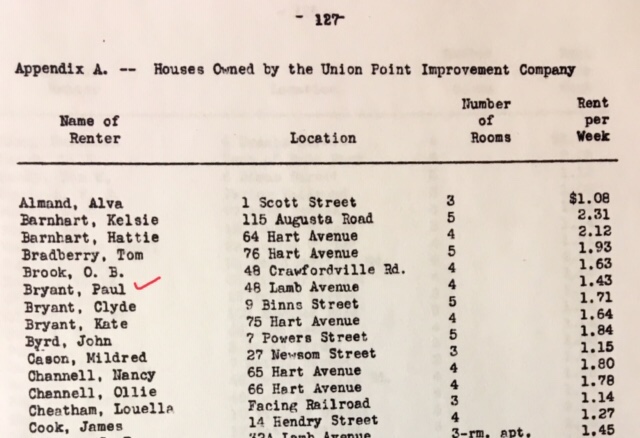
My grandfather, Paul Bryant (Bryan) listed at 48 Lamb Avenue
48 Lamb Street was a 4-room house with a cost of $1.43 a week. I’m assuming it was a two bedroom with a kitchen and a living room… having open porches on both ends. From the ones I remember, the front porches were enclosed with screen wire… which may have been done over the years by the renter, and at their expense. The back open porch wasn’t very large. While this house is no longer there, I’m told all the ones on the street by the mill pretty much all looked alike. I do have a vague memory as a young girl of seeing that long line of white mill houses.
Granddaddy’s brother Clyde Bryant (Bryan) was listed as living at 9 Binns St., paying $1.71 weekly. Eventually my grandfather bought the dead-end lot on Binns Street and built a house after the 1940 census was taken; he was listed as living in mill housing on the 1940 census.
When my uncle Floyd and Aunt Vivian Bryan (son of Paul Bryan) returned home from the Navy in 1946 he and Aunt Vivian bought the house next door to his parents. They both soon began working at the mill, but later moved to Hickory N.C. in 1950 for more work opportunities; it was a booming hosiery town.
My parents moved back to Union Point after Daddy left the Navy in 1949 and built a house on the corner of Binns and Wotton Ave… one house away from his parents. My granddaddy McKinley purchased the lumber and granddaddy Bryan built our house. In being with the times… Granddaddy McKinley bought the lumber of a house being torn down… the generation of the true green “recyclers” – they threw nothing out, which could be reused; everyone had a pile of junk saved somewhere behind a garage… to pick through when something was needed. I can only imagine the “junk pile” they kept at the mill!
My family remained in Union Point until later moving to Perry about 1957. I’ve always wondered why my father didn’t work at the mill, but I can only surmise that from his training in the Navy as a technician gave him skills to pursue a career in the television repair field and later as a technician at Warner Robins Air Force Base in Warner Robins, Georgia.

My grandparents home sat at the end of a dead end on Binns St. Our house was also on the same block… one house away from theirs.

Mill Apartments on Moody St. (Hwy. 77)
There were varied type housing offered… from houses to apartments, but all were bare basics. The houses had open porches on both ends with outside toilets and water was only piped to about 10 feet from the back door. There was no electricity in the beginning, kerosene lamps were used for light and coal for heat… which was bought through the mill. Inside toilets weren’t installed in the housing units until 1937.
The average rents were “averaged” per room… ranging from 40 to 50 cents per room, per week, with apartments renting slightly lower than housing. On a random inspection of twenty-three house, 16 did not have running water, while 7 did. One house had an indoor toilet, with the rest outside toilets and one house had a bathtub.
Anything and everything the mill supplied to their employees!
Many mills ran stores for their employees to shop in and the Union Manufacturing Co. was no exception. They ran the Super Service Station, which offered a gas service station, groceries, and a meat market. The station was owned in partnership with Mr. F. S. Bryan (VP of mill) and Mr. Owen A. Scott (VP & Superintendent of mill)
Later, the mill even set up its own electrical system around 1926 – Mill Village Electrical System. Before 1938, employees were sold electricity and deductions made through their payrolls.
The Meredith Optical Co. of Augusta sent annually an optician to Union Point to examine employees eyes and fit them with glasses if needed. Prices for new glasses ranged from $7 to $20 dollars… and were deducted from their wages.
In the early 1930’s, the mill also began making small loans to their employees… most likely a practice of many corporations at that time. People didn’t go to banks like they do today… and many didn’t trust banks at that time. The mill borrowed from the Bank of Union Point, charging them a slightly higher rate of interest, or a fee of one-dollar. Again, your loan was repaid through your weekly wages, often over a ten week period. By the 1940’s, they stopped making new loans and dissolved the business. Most likely, at that time, employees were beginning to deal more with banks and not relying on their work employment for everything they needed.
Deductions on payrolls were for houses/rents, grocery/gas/store, electricity, coal, loans and miscellaneous items such as eye glasses. They made it easy for them, but makes me wonder what was left in their weekly paychecks… but at that time, if they didn’t buy on time, they might not have been able to have some of the things they needed. While many may have budgeted well, I’m sure some over-extended themselves and often ended up with almost no paycheck at times.
Just like today, if you are a mechanic, you supply most of your working tools. I always questioned that to my husband, who replied, “if the company supplied all your tools, many wouldn’t take care of them and many would “walk” away.” So it seems that times haven’t changed in that respect.
I found many family members making purchases through the mill for various items, either to perform their work jobs or for home use. It was recorded that my great uncle Clyde Bryant (Bryan) bought many pounds of cotton batting… my grandmother, Evelyn Bryan, sewed quilts… she must have bought her batting from there also? It wasn’t like we had craft stores back then, but I do remember sewing stores around with bolts and bolts of fabric. The women did much more sewing then… from their clothes to the many quilts that warmed their beds. We always had more quilts in our house than needed… and I still have a few of my grandmothers.
1940:

All my Bryan family was listed as “Bryant” in their books… maybe they listed them to distinguish from the Bryan family who owned the mill. Neither family was related as their family had been established there for many years before my Bryan line moved to Union Point, Georgia. I also found many misspellings of their name in the document… such as Bryon.
Miscellaneous Items bought through the Mill Store
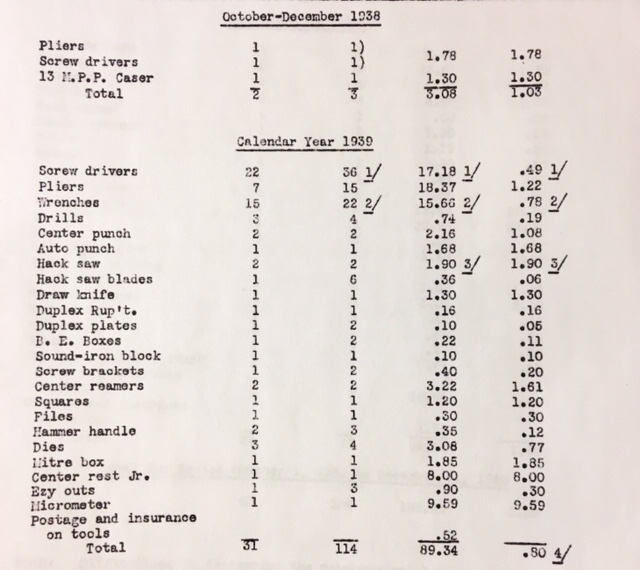
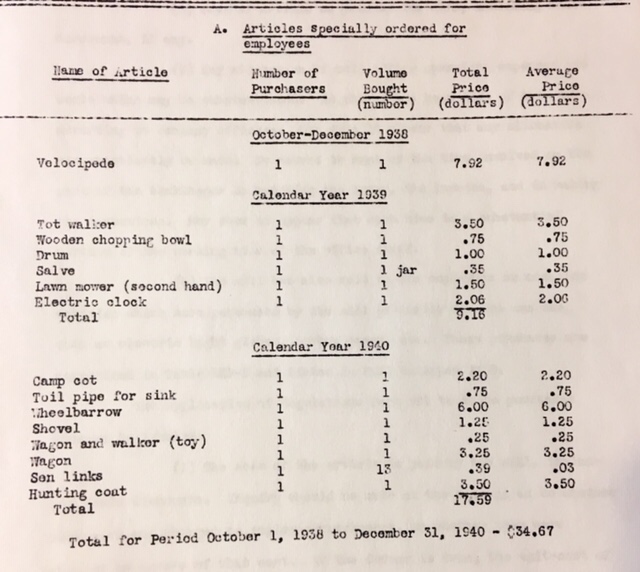
I also found it interesting in this document that, prior to 1939, the employees in several departments joined together to buy ice to cool their drinking water used during working hours; deductions were made through payrolls. At one point, they finally purchased two mechanical water coolers… also purchased by the employees and paid for through deductions. Imagine today, if a company asked employees to buy through own water and coolers… how times have changed!
What once was a busy area of workers coming and going on shift changes… to the tune of the daily whistle… now sits silent… with only its ghosts and memories.
Click for more … Family Stories
© 2019, copyright Jeanne Bryan Insalaco; all rights reserved









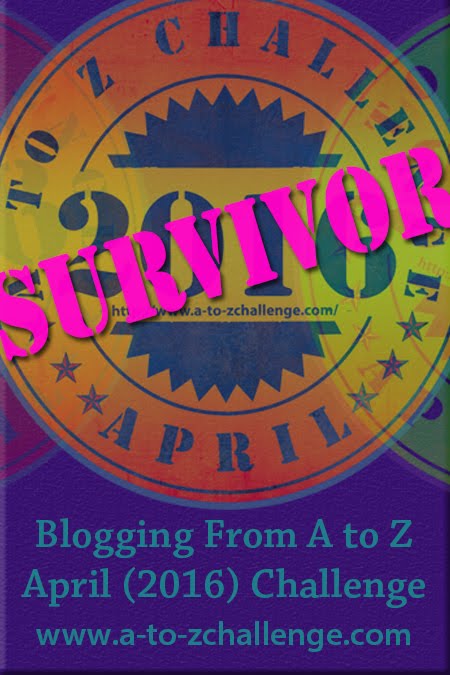



Very Interesting , wish someone would do similar research & post it about the Mary Liela Mill in Greensboro. My parents moved me to Greene County from Wilkes County when I was Six Wks. old, Daddy hauled board lumber to both Greensboro Lumber Co. & Knox Bros. Lumber Co. just outside Greensboro toward Union Point. We had relatives who worked at Union Mill and lived at Union Point. THKS for your research and posting this historical document.
LikeLiked by 1 person
Thank you for reading and your kind words. Maybe I can look into the Mary Leila Mill.
LikeLike
Terrific research and pictures. Great story.
LikeLiked by 1 person
Thank You
LikeLike
Jeanne,
My grandparents and most of family worked there at different times
I also remember you from high school
LikeLiked by 1 person
I didn’t go to high school in Greensboro or Union Point as my parents moved down to Perry. I spent lot of time in Siloam and Union Point though
LikeLike
Thanks for reading. Do you still have a blog, the link here I never can access. Can you post me a link to your new blog if one?
LikeLike
Ooh it hasn’t changed. Try http://www.antoinettetrugliomartin.com. or http://Www.atmartin.com. hope to see you there.
LikeLiked by 1 person
That one works. This is what shows up for me to click on. antoinettetrugliomartin.wordpress.com is no longer available.
The authors have deleted this site.
LikeLike
Thanks. I’ll check on this
LikeLiked by 1 person
Reblogged this on LIVING THE DREAM.
LikeLiked by 1 person
Thank You for the “Reblog.”
LikeLike
I enjoyed reading your article and appreciate your research. My grandparents worked at the mill in Greensboro and lived in the “mill village”. My grandfather moved to Mill Street when he was a little boy after the death of his father. He lived his whole life on or around Mill Street. I loved that old house!
LikeLiked by 1 person
Happy to have local readers.
LikeLike
I would love to see more of the original files if you could share them. I think my grandfather might be the R B Moody listed in the tool listing.
LikeLiked by 1 person
Are you in the Greene County History Facebook group? Search on Facebook and I will add you. In the Files there – I have 2 files on the mill. Let me look for the link online also to post here. You can read it online but not download unless you know someone at a college
LikeLike
Here is the direct link to the PDF on the mill: But if you are from Greene Co. or your family do join up on the Facebook Group. https://catalog.hathitrust.org/api/volumes/oclc/26681133.html
LikeLike
Search as this… GREENE COUNTY GEORGIA HISTORY on Facebook for the group. The group photo is the Greene Co. Courthouse with snow on it.
LikeLike
Wonderful research. I want to do something like this for the glass factory where my grandfather worked back in 1915 in Kansas. Well done!
LikeLiked by 1 person
Yes I was excited when I stumbled upon that financial document / a wealth of info.
LikeLike
My husband’s parents worked in the mills in Maine, but most of those mills closed down as more moved south.
LikeLiked by 1 person
Those old mills were responsible for keeping towns alive.
LikeLike
Enjoyed reading this article. I worked at the mill as a teenager around 1992. All through high school. My daddy worked there 20 plus years. 😊
LikeLiked by 1 person
Thank You for reading! The mill sustained almost every family in town. Sad to see it empty now!
LikeLike
Fantastic research! My grandmother worked at Chipman Union stretching socks over hot metal forms. Her name was Corene Hensley! I remember her coming home from work each evening sometimes bringing us Jack’s cookies. She could not drive so she caught rides with neighbors who worked there.
LikeLiked by 1 person
Possibly our grandmothers might have known each other.
LikeLike
Hello Jeanne,
This is Michael Hardester, and I am putting together a video for the new Union Point museum. It is a video that is going to be on continuously. I happened upon your article and was curious if there would be any way you would be willing to share some of you pictures with me for the video. you have some pictures that would really help tell Union Points story. Please let me know if you would be willing to share.
Thank you,
Michael Hardester
LikeLiked by 1 person
Yes I’m happy to share. Feel free to also use any info from my blog or add a link for people to go read. Post me your email to me and I’ll work on sending photos.
LikeLiked by 1 person
Oh my Goodness, you are awesome!!!
mdhardes@gmail.com
Thank you so much!!!
LikeLiked by 1 person
In email lmk which photos you’d like
LikeLike
Any of the photos you are willing to share I will use!
Thank you!
LikeLiked by 1 person
My grandfather is listed in the linked file above https://catalog.hathitrust.org/api/volumes/oclc/26681133.html
He was the Foreman of the Textile department and rented 12 Witcher Street for $1.97 per week in 1939
His name was Marshall Alexander Finch (1888-1967)
His children were William Marshall, Gordon, Earl, Harold, Imogene, Roy, Aubrey & Virginia Finch. All of them worked at the Mill except Aubrey & Virginia
Thanks for posting the history of the mill!
LikeLiked by 1 person
Hello William. So glad you found my article. We lived on Binns St. And I believe a Finch family lived directly across from us on the corner… was that someone from your line? My grandfather was Paul Bryan, who also lived on Binns St at the end.
LikeLike
Today is my 73rd birthday, and the best present I received was finding this article while searching for old photos of Union Point.
My mother (Juanita Yearwood) worked in the mill for about 20 years, late 1940s-late 1960s. We lived in a mill house at 206 Wotton Avenue until the early 1960s.
I remember Mr. Paul and his limp, Jim & Louella Lewis and Joe the mynah bird. “Birds can’t talk” was a catchphrase among boys my age.
The “rat hole” was truly terrifying if you were a youngster. We would dare each other to walk through it alone at night.
I recognize a lot of the names on the various mill documents you’ve included.
I wonder if the person who thinks he remembers you from high school might be confusing you with Jennie Bryan (Sheffield), of the Bryan family prominent in mill history, sister of Sibley Bryan Jr, I think. She did attend Union Point High School.
Union Point: first the high school closed (1965, after my freshman year), then the mill shut down, now the town as we knew it is just a shell of a memory. In case you didn’t know, the building on the far-right end of the one-sided street, at the corner of Sibley Avenue and Fluker Street, recently collapsed. The newspaper article said the cause was high winds. The building had been abandoned, like many of the downtown buildings.
Thanks for this article. I just found it, haven’t explored your site in depth. Any other posts relating to Union Point?
LikeLiked by 1 person
Always happy to hear from someone from Union Point. Sorry to hear that building collapsed as it was standing last July when we rode through. Lots of good memories in that town. So sad seeing it in a state of ruins but I always ride through when we’re stopping for some Holcomb BBQ. There’s a search bar on the right about halfway down that you might try. Happy Birthday!!!
LikeLike
So cool. I live in a old house in Union Point on Carlton ave., it’s across from the new coming firefly trail. One of my clients (I’m a hairdresser) told me my house was known to the older generations as hillside cottage. I love to learn the history of this town. My husband grew up here, and his family has been here many years! Glad to learn more about this town. I walk by the rat hole often and thought it was just a giant culvert pipe! I’ll have to walk through it now!
LikeLiked by 1 person
I so miss this little town I was born in. I lived in Binns st snd my grandfather lived at end of street. So many memories
LikeLike
Thanks, Jeanne, for your amazing nostalgic post including pictures! My Union Point memories are a bit different from the others here. My family moved from Southern California to Union Point in late 1962. We were relatives of FS and Phyllis Bryan (“Mr Sib and Miss Phil”). Upon arriving, we were privileged to stay for a short time at their grand home, Hawthorne Heights, overlooking the railroad depot and “downtown” Union Point. After moving into our temporary house on Dolvin Ave, I attended 5th grade in Mrs Freeman’s class and my sister, Leslie, attended 3rd grade with Mrs Newsom. I remember Union Point as a welcoming, friendly place, especially on a Sunday morning when Bill Carlton arrived astride his pony in our front yard introduced himself and asked if I wanted to take a ride! He and I had a lot of fun racing around on his go cart, shooting at squirrels, and teasing his older sister, Knoxie. The Beverly Hillbillies was popular on TV then and I watched it for the first time at the Carlton’s house.
Other kids I remember are Louie Carlton, Richard Stewart, Twinkie Boyd, Fred McCannon, and Gregory Baugh. I saw Darryl Yearwood’s comment above and I remember him too. We are about the same age, but I imagine our lives have been very different.
I can still smell the aroma of Miss Alice’s fresh baked rolls coming down the main hall from the cafeteria school EVERY DAY at around 11:30. Mouth-watering! I also remember the crack of Mr. Acree’s paddle as it smacked a naughty boy’s rear end; it was a sound that echoed down the main hall for all to hear, as a stern warning to any would-be smart aleks.
I have great memories of driving to Atlanta a few times with a group of Georgia Tech Yellow Jacket fans , including my Uncle Sib and Jimmy Scott. I even got a chance to have lunch at The Varsity near the Tech campus. Such wonderful fall traditions.
We happened to be living in Union Point in October 1962, during the Cuban Missile Crisis—scary times. Talk was that because Georgia was so close to Cuba we’d be one of the first targets in a war. “Might not wake up tomorrow,” kids said!
My last visit to Union Point was in July 1969 and I watched the moon landing on TV at Hawthorne Heights. I use Google Earth street view now to “walk the streets” there and notice how things have changed. It’s amazing how vivid the memories are after 60+ years and how I can still find my way around on the map.
I feel so lucky to have spent time in Union Point. I’ve travelled all over the world since then, but that was my first chance to immerse myself in a very special “foreign culture.”
LikeLiked by 1 person
Hello fellow Union Pointer… always happy to have new friends stop by and share memories. I don’t live there anymore but it holds fond memories.
LikeLike